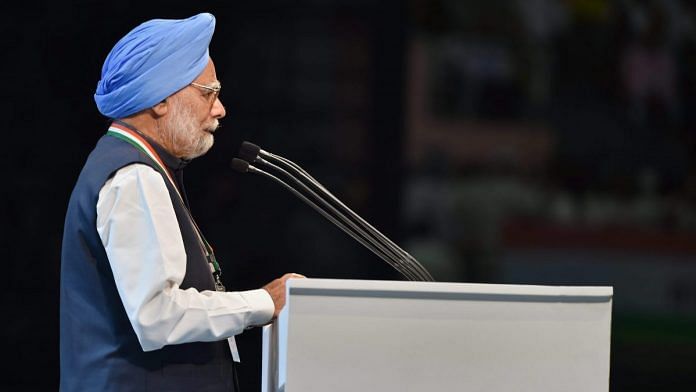Manmohan Singh, Chidambaram spoke amid huge cheers from Congress workers; even former PM Narasimha Rao was recalled for his contribution to economic reforms.
New Delhi: Among the many firsts at this year’s Congress plenary session was the attention and appreciation non-Gandhi family leaders like Manmohan Singh and P. Chidambaram received from party workers.
On the second day of the event on Sunday, Singh was invited to speak amid loud cheers from party workers who assembled at the Indira Gandhi Indoor Stadium from across the country.
There was a lot of excitement and energy among the crowd when the former PM started talking about the achievements of the erstwhile UPA government. When he finished, Singh received a standing ovation from the entire crowd — perhaps something new in his entire political career.
Singh was not the only one. Former finance minister P. Chidambaram was applauded and cheered for every line of his speech.
These party faces, who were considered backroom strategists rather than mainstream leaders until now, had suddenly received a hero’s welcome.
The political resolution of the Congress plenary also lauded the contribution of former prime minister P.V. Narasimha Rao, seen to have been treated as an outcast by the party for many years.
“As PM, he (Rao) steered the country out of engulfing crisis. The economic reforms of 1991 were truly historic and transformed Indian economy,” read the political resolution.
Rao, considered the architect of India’s economic reforms, fell from grace after the Babri Masjid demolition in December 1992 and he rarely found a mention within the party for the next one decade.
In 2001 Bangalore party plenary, he was brought to the stage by Sonia Gandhi and he had presented a document ‘Liberalisation and the Public Sector’ where he had highlighted how liberalisation opened way for the private sector to coexist and compete with the public sector.
He was again forgotten after that only to find a mention in the 2010 Burari plenary in Delhi.
In 2015, Jairam Ramesh was the first leader who came openly in support of Rao. In an interview, he said, “The party must not be apologetic of economic reforms. Also, it should be proud that Rao was a Congress PM. We may have differences with him on issues like Ayodhya, but we need to understand that he introduced economic reforms in India, which strengthened Indian economy and improved our global standing.”
In contrast, the Congress has always credited Manmohan Singh for the economic reforms, who was the finance minister in the Rao government.
During UPA-II, however, Rahul Gandhi appeared to be distancing himself from Manmohan Singh government’s policies a couple times. The difference between the Gandhi scion and the government reached its peak in September 2013 when, Rahul tore apart an ordinance to shield convicted leaders.
But the changed economic scenarios and Modi government’s policies such as note ban and GST shifted the focus back to Manmohan Singh who had termed 8 November 2016 as a ‘black day for Indian democracy and economy’.
At the plenary, Singh continued his attack on the Modi government by saying, “The BJP government has messed up the economy.”
After Singh, Chidambaram made a strong speech while presenting the economic resolution of the party, comparing the numbers of both the UPA and NDA governments.
“We have done it before and we will do it again,” was his strong message to the Congress workers to bestow trust in the leaders and the party.




Between 2004 and 2014, during UPA rule, more than trillon dollars flow out of the country.